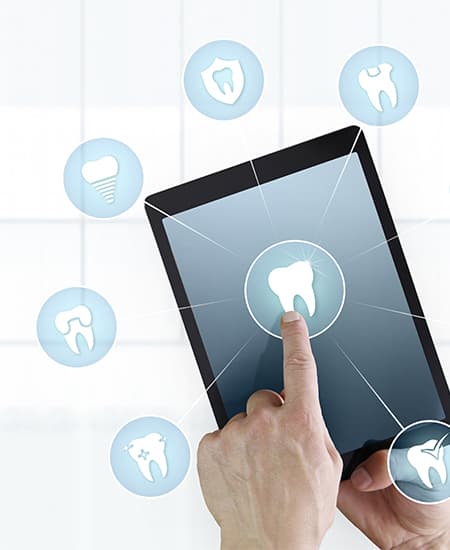Degree Structure
College
Dental Medicine
Department
Level
Undergraduate
Study System
Courses
Total Credit Hours
1 Foundation year + 5 years = Total 6 Years 220 Cr. Hrs
Duration
6 Years
Intake
Fall Only
Language
English
Study Mode
Full Time
Begin your academic journey with our user-friendly online application platform.
Important Dates
Get access to expert guidance.

Degree Overview
The College of Dental Medicine was established in 2004. It marked a significant step in the University of Sharjah's expansion into medical and health sciences.
A key aspect of the CDM's early development was its collaboration with the University of Adelaide in Australia. This partnership involved adapting their Bachelor of Dental Surgery program to fit the local culture, healthcare system, and learning environment of the UAE. The University of Adelaide provided curriculum, teaching expertise, and resources and assisted with academic policies, accreditation documentation, and staff recruitment. The current program consists of three phases: a foundation year, Integrated Dental Sciences, and Dental Clerkship, followed by a calendar year of internship.
What You Will Learn
Dentists work to improve oral health in our communities. They’re lifelong learners who care about their patients and their work.
Our Bachelor of Dental Surgery supports you in becoming a highly skilled and patient-focused dentist. You will:
- Build clinical experience starting in your very first year
- Learn in UoS’s dental teaching hospital, in the state-of-the-art Dental Medical S building
- Explore the full range of dental therapies — from complex restorative to preventative-based treatments
- Practice using equipment in our Dental Simulation Clinic
- Tackle real-life case scenarios in teams
University Requirements
College Requirements
Degree Requirements
| 1. Continuum of Dental Education |
| The curriculum will provide an educational experience that ensures continuing development from undergraduate to internship and further graduate training. |
| 2. Outcome Competency Based Curriculum |
| Core competencies essential for good dental practice guide the structure of the curriculum, organization, learning and teaching approaches, student assessment outcome, and program evaluation. |
| 3. Integrated Curriculum |
| The thematic organization of the curriculum is based on streams, and the building of new knowledge and skills based on experience in a previous stream allows a horizontal and vertical integration of the teaching-learning activities such that an excellent appreciation of the basic and clinical science is achieved. |
| 4. Early Introduction of Clinical Dentistry |
| This approach allows early understanding of patho-physiological principles and generates the eagerness to know more; it further enables fine skills to be developed at a very early phase of education so that difficult hand skills learning abilities are identified and rectified early in the program. |
| 5. Student-Centered Flexible Learning |
| The learning environment will be structured to allow more flexibility and choice in time, place, and style of learning. |
| 6. Problem/Team Based Learning |
| The direct relevance of the practice of dentistry will be emphasized by the use of patients' problems and conducting these problem-solving exercises based on sound medical, dental, and social sciences evidence-based principles. |
| 7. Community-Based Context |
| The course will emphasize the appropriate needs of dentistry in the community with special interest in the rural environment. |
| 8. Leadership Quality |
| Courses will be delivered in a way that makes the student a future leader in a health team, practicing teamwork, promoting the scientific method of problem-solving, and being a lifelong learner to ensure his/her competitiveness and relevance throughout his/her career. |
| 9. Constructive Assessment |
| The assessment methods will enable recognition of one's strengths and weaknesses, with the ability to improve and achieve goals for long-term professional qualities rather than short-term superficial learning. |
| 10. Yearly Assessment System |
| The continuous assessment system is reported on an annual basis made at the end of each year to enable early recognition and rectification of areas that demand attention. The curriculum has been adapted from the University of Adelaide Bachelor of Dental Surgery Program with modifications and adaptations made to fit the local culture, health care system, and learning environment of the United Arab Emirates. |
| Phase I: Foundation Sciences |
| The first year at the University prepares students to achieve a level of knowledge necessary to assimilate the more challenging medical and dental science subjects in the later phases. Students will be exposed to new learning methods in both physical and biological sciences in the form of problem-based learning, group projects, critical and lateral thinking, scientific literature search, and academic writing. Self-directed learning philosophy will be emphasized, and other academic and social activities are conducted to mold a smooth transfer from high school education to University Campus life. |
| Phase II: Integrated Dental Sciences |
| The Phase II program runs over the course of three academic years - First, Second, and Third Years (BDS 1, BDS 2, and BDS 3) - and consists of teaching-learning activities that are delivered in four streams: Dental Health Sciences, Dental Clinical Practice, Human Biology, and Community Dentistry. |
| Dental and Health Sciences I, II, and III |
| Dental and Health Sciences I forms the basis of oral anatomy and physiology that integrates with cell biology. The Dental and Health Science III stream includes physiology and disturbance of the masticatory system, disorders of the dental hard tissue, dental radiology, and introduction to oral surgery, among others. |
| Dental Clinical Practice I, II, and III |
| Dental Clinical Practice I introduces students to the general dental practice environment. The Dental Clinical Practice III stream builds on previous years, concentrating on advanced restorative techniques and total dental rehabilitation of patients by introducing prosthodontics, endodontics, and more complex conservative techniques. |
| Human Biology I, II, and III |
| The Human Biology I stream begins with a detailed understanding of human cell biology. This leads to the Structure and Function of the Human Biology II in the Second Year that includes anatomy and physiology of body systems. Human Biology III includes aspects of general and oral pathology, microbiology, immunology, and pharmacology. |
| Community Dentistry I and II |
| Community Dentistry I and II provide the basis for the students from multicultural backgrounds to adopt critical thinking and professionalism. The stream consists of units that provide exercises in communication and learning skills, research methodology, and social context of dentistry. |
| Phase III: Dental Clerkship |
| The Phase III or Dental Clerkship encompasses two integrated years – the Fourth and Fifth Years (BDS 4 and BDS 5) of study – of full-time clinical rotations in four major dental and medical disciplines. A strong emphasis will be placed on clinical community dentistry and outreach activities. |
| Assessment Philosophy |
| The College runs an annual assessment system. The final marks for graduation are accumulated in Phase III only. Grading in the University requirements and electives are not considered in the overall final grade. The assessment system is designed to be fair, transparent, and supportive of student learning and professional development. |
Course Description
Phase I: Foundation Year
For more detailed information on foundation year in dentistry please refer to the College of Medicine. The Foundation Year is a medical sciences preparation year and admission to the BDS 1 year is competitive and limited by available seats.
Phase II: First Year - BDS 1
Human Biology 1
This stream consists of an integrated cluster of the following areas:
- Human Cell Biology, Molecular Biology and Genetics
- General Histology
- Medical Physiology
Dental and Health Sciences 1
This stream consists of an integrated cluster of the following areas:
- Dental Terminology
- Dental Anatomy, Physiology and Occlusion
- Basic Anatomy of Masticatory System
- Forensic Dentistry
Community Dentistry 1
This stream consists of an integrated cluster of the following areas:
- Epidemiology
- Introduction to Bio-Statistics
- Evidence- Based Dentistry
- Introduction to Statistical Analysis
Dental Clinical Practice 1
- Introduction to general dental practice
- Preliminary History taking, Physical Examination, Charting and Record Keeping.
- Preventive Dentistry and Cariology
- Periodontology
- Basics of Radiology
- Basic Dental Biomaterials
- Introduction to Operative Dentistry - Basic Terminology, Skills and Instruments
- Dental Ergonomics and 4-handed dentistry
Assessment and Promotion
Assessment of each stream for promotion to BDS 2 is based on the following criteria:
- First Semester
- Mid Semester
- Mid Year Examination
- 15%
- 20%
- Second Semester
- Mid Semester
- End of year Examination
- 15%
- 50%
The components of the examination consist of:
- MCQ examination
- short answer questions
- objective structured practical examination
- laboratory practical test
- a written project assignment.
The final result for each stream is the sum of the marks obtained throughout the year. The passing mark for each stream is 60%. Students must pass all streams to be promoted to the second BDS year. The final annual result is the average of the results of all streams. The passing mark is 70%. Failure in a stream will require 'repeat examinations' for that stream in the same year. Failure in the 'repeat examination' will require the student to repeat the whole year. Students must complete and pass all streams in the repeat year.
Phase II: Second Year - BDS 2
Human Biology 2
This stream consists of an integrated cluster of the following areas:
- Medical Physiology
- General and Head and Neck Anatomy
- Neuroanatomy
Dental and Health Sciences 2
- Dental and Craniofacial Embryology
- Oral Histology
- Biochemistry
Community Dentistry 2
- Evidence-Based Dentistry
- Behavioral Medicine and Social context of Dentistry
Dental Clinical Practice 2
- Operative Dentistry
- Periodontology
- Basic Dental Radiology
Assessment and Promotion
Assessment of each stream for promotion to BDS 3 is based on the following criteria:
- First Semester
- Mid Semester
- Mid Year Examination
- 15%
- 20%
- Second Semester
- Mid Semester
- End of year Examination
- 15%
- 50%
The components of the examination consist of:
- MCQ examination
- Short answer question
- Objective structured practical examination
- Laboratory practical test
- A written project assignment
The final result for each stream is the sum of the marks obtained throughout the year. The passing mark for each stream is 60%. Students must pass all streams to be promoted to the third BDS year. The final annual result is the average of the results of all streams. The passing mark is 70%. Failure in a stream will require 'repeat examinations' for that stream in the same year. Failure in the 'repeat examination' will require the student to repeat the whole year. Students must complete and pass all streams in the repeat year.
Phase II: Third Year - BDS 3
Human Biology 3
This stream consists of an integrated cluster of the following areas:
- General Pathology
- Oral Pathology
- Microbiology
- Immunology
- Pharmacology and therapeutics
Dental and Health Sciences 3
This stream consists of an integrated cluster of the following areas:
- Craniofacial growth and development
- Craniofacial Deformities
- Disorders of the masticatory system
Dental Clinical Practice 3
This stream consists of an integrated cluster of the following areas:
- Advanced Operative Dentistry
- Endodontics
- Removable Prosthodontics
- Applied Biomaterial Science
- Preventive Dentistry
- Periodontology
- Pain Control Techniques
- Oral Radiology Techniques
Assessment and Promotion
Assessment of each stream for promotion to BDS 4 (Phase III) is based on the following criteria:
- First Semester
- Mid Semester
- Mid Year Examination
- 15%
- 20%
- Second Semester
- Mid Semester
- End of year Examination
- 15%
- 50%
The components of the examination consist of:
- MCQ examination
- Short answer question
- Objective structured practical examination
- Laboratory practical test
- A written project assignment
The final result for each stream is the sum of the marks obtained throughout the year. The passing mark for each stream is 60%. Students must pass all streams to be promoted to the Fourth BDS year. The final annual result is the average of the results of all streams. The passing mark is 70%. Failure in a stream will require 'repeat examinations' for that stream in the same year. Failure in the 'repeat examination' will require the student to repeat the whole year. Students must complete and pass all streams in the repeat year.
Phase III: Years 4 and 5 - BDS 4 and 5
Dental and Health Sciences and Dental Clinical Practice
Both streams are closely coordinated and they consist of an integrated cluster of the following major clinical rotations:
Dental Clinical Practice 4A and 5A
This stream consists of an integrated cluster of the following areas:
- Clinical Preventive and Operative Dentistry
- Endodontics
- Removable and Fixed Prosthodontics
- Periodontics
Dental Clinical Practice 4B and 5B
This stream consists of an integrated cluster of the following areas:
- Population Health
- Ethics and professionalism
- Orthodontics
- Pediatric Dentistry
Dental and Health sciences 4 & 5
This stream consists of an integrated cluster of the following areas:
- General Medicine and Surgery
- Oral Medicine and Oral Pathology
- Oral and Maxillofacial Surgery
- Oral Radiology
- Oral Diagnosis
The Dental Clerkship in the 3 Majors Rotations over a period of two academic years are as follows:
| Clinical Rotations | Stream | Year |
| 1. Restorative Dentistry | DCP 4A | BDS 4 |
| 2. Community Dentistry | DCP 4B | BDS 4 |
| 3. Oral Medicine and Oral surgery | DHS 4 | BDS 4 |
| 4. College Selective 4 | - | BDS 4 |
| 5. Restorative Dentistry | DCP 5A | BDS 5 |
| 6. Community Dentistry | DCP 5B | BDS 5 |
| 7. Oral Medicine and Oral Surgery | DHS 5 | BDS 5 |
| 8. College Selective 5 | - | BDS 5 |
Assessment in Phase III (years 4 and 5)
The Phase III assessment consists of a continuous assessment throughout the two integrated years followed by a summative assessment at the end of fifth year. The continuous assessment is derived from the examinations at the end of every dental clerkship rotation. The passing mark for each major clinical rotation is 60%.
Students in BDS 4 must obtain an average of 70% among all clinical rotations to be promoted to BDS 5.
Students are admitted into the final BDS Exit Examination after completing all the clinical schedules, project assignments, elective project reports and passed all clerkship rotations. Students must pass all three major clinical rotations in both theory and clinical components of the examination, and must obtain an average of 70% to be eligible to sit for the Final BDS Exit Examination.
The assessments in all the clinical rotations over the two years will carry 60% marks and the final BDS Exit Examination will carry 40% marks.
The components of the assessment consist of:
- MCQ examination
- Short answer question
- Objective structured practical examination
- Laboratory practical test
- A written project assignment
Compilation of marks in Dental Clerkship Year
Assessment in BDS4 30%
Assessment in BDS5 30%
Final BDS Exit Examination 40%
The final BDS Examination will be held in May of each year. Students who fail in the final BDS Examination in May will be counseled and allocated to the respective clinical rotations to improve their competencies. They will then resit for the Final BDS Examination in the beginning of the next academic year.
GENERAL EDUCATION REQUIREMENTS
Every student is required to take 24 credit hours of general education courses distributed over six domains. Twelve (12) mandatory credit hours are selected from domains 1, 2, and 3, and twelve (12) elective credit hours selected from domains 4, 5 and 6 as indicated below. Students are advised to finish these courses by the end of year 3 of their study .
Domain 1: Islamic Studies, History and Culture (3 Credits)
- 0104100
- Islamic Culture
- 3
Domain 2: Languages (6 Credits)
Arabic Language, Literature and Culture: Take one of the following courses
- 0201102
- Arabic Language (for native Arabic speakers)
- 3
- 0201105
- Arabic Language (for non-native Arabic speakers)
- 3
English Language, Literature and Culture: Take one of the following courses
- 0202121
- English for Medical Students
- 3
Domain 3: Information Technology (IT) (3 Credits)
- Introduction to IT
- 3
Domain 4: Literature and Humanities (3 Credits)
| 0602246 | Human Rights in Islam and International Declarations | 3 |
| 0203102 | History of the Arabian Gulf | 3 |
| 0900107 | History of Medical and Health Sciences | 3 |
| 0710109 | Arts and Medicine | 3 |
Domain 5: Applied Sciences, 3 Credits
| 1430101 | Astronomy and Space Sciences | 3 |
| 0401142 | Man and the Environment | 3 |
Domain 6: Social Sciences and Education (3 Credits)
| 0204102 | UAE society |
3 |
| 0206103 | Introduction to Psychology | 3 |
| 0305110 | Introduction to Economics | 3 |
| 0302120 | Introduction to Business Administration | 3 |
Domain 7: one 3-credit hour course from Domain 4, 5, or 6
Career Path
Qualified graduates have the opportunity to pursue a range of positions, including leadership roles, within the realm of health sciences. They can offer dental services in both public and private sectors, spanning police or military services, health-related industries, educational institutions, and community settings like hospitals, health clinics, schools, universities, and primary healthcare centers. Additionally, they may extend their services to rehabilitation centers, elderly homes, social centers, and research institutes seeking dental expertise.

How will you make an impact?
Every student’s journey at UoS and beyond is different, which is why our Career & Professional Development team provides personalized career resources to help students make an impact for years to come.





